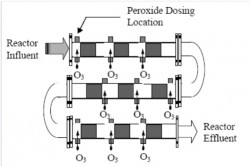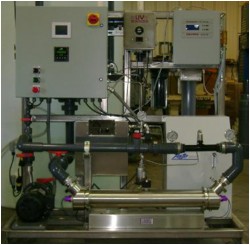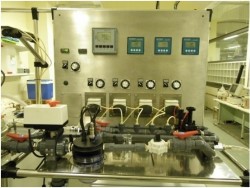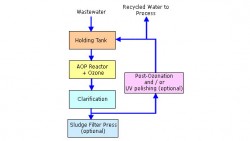Advanced oxidation processes (abbreviation: AOPs), in a broad sense, refers to a set of chemical treatment procedures designed to remove organic (and sometimes inorganic) materials in water and waste water by oxidation through reactions with hydroxyl radicals (·OH). In real-world applications of wastewater treatment, however, this term usually refers more specifically to a subset of such chemical processes that employ ozone (O3), hydrogen peroxide (H2O2) and/or UV light. One such type of process is called in situ chemical oxidation.
AOPs rely on in-situ production of highly reactive hydroxyl radicals (·OH). These reactive species are the strongest oxidants that can be applied in water and can virtually oxidize any compound present in the water matrix, often at a diffusion controlled reaction speed. Consequently, ·OH reacts unselectively once formed and contaminants will be quickly and efficiently fragmented and converted into small inorganic molecules. Hydroxyl radicals are produced with the help of one or more primary oxidants (e.g. ozone, hydrogen peroxide, oxygen) and/or energy sources (e.g. ultraviolet light) or catalysts (e.g. titanium dioxide). Precise, pre-programmed dosages, sequences and combinations of these reagents are applied in order to obtain a maximum •OH yield. In general, when applied in properly tuned conditions, AOPs can reduce the concentration of contaminants from several-hundreds of ppm to less than 5 ppb and therefore significantly bring COD and TOC down, which earned it the credit of “water treatment processes of the 21st century”.
The AOP procedure is particularly useful for cleaning biologically toxic or non-degradable materials such as aromatics, pesticides, petroleum constituents, and volatile organic compounds (VOC) in waste water. The contaminant materials are converted to a large extent into stable inorganic compounds such as water, carbon dioxide and salts, i.e. they undergo mineralization. A goal of the waste water purification by means of AOP procedures is the reduction of the chemical contaminants and the toxicity to such an extent that the cleaned waste water may be reintroduced into receiving streams.
AOP Purposes:
The AOP (Advanced Oxidation Processes) is usually used for removing contaminants from waste water coming out of several types of heavy industries like:
- Petrochemical & Plastic Industry
- Chemical Industry.
- Food Processing Industry
- Pharmaceutical Industry
- Metal and Metal Plating Industry
- Textile and Dying Industry
- RO & NF brine streams
Advanced chemical oxidation processes make use of (chemical) oxidants to reduce COD/BOD levels, and to remove both organic and oxidisable inorganic components. The processes can completely oxidize organic materials to carbon dioxide and water. AST is using a wide variety of advanced oxidation processes.
Chemical oxidation processes using hydrogen peroxide, ozone, combined ozone & peroxide CLO2 Ultra Sound & Ultra-violet enhanced oxidation such as US/UV/ozone, US/UV/hydrogen peroxide, US/UV/air and catalytic reagent. Advanced Oxidation Processes are particularly appropriate for effluents containing refractory, toxic or non-biodegradable materials.
The processes offer several advantages over biological or physical processes, including:
- Process operability(No biological process)
- Unattended operation with very small foot print.
- The absence of secondary wastes (sludge).
- The ability to handle fluctuating flow rates and compositions.
Conventional oxidation processes are very often high capital and operating costs and not effective in reducing the COD contamination from the waste water.
Conventional oxidation processes such as biological treatment, demands long operating cycle (up to 48 hours) and very big footprint.
The main process steps are as follows:
- Sedimentation of suspended solids or filtration depending on the level of TSS (Total Suspended Solids)
- pH adjustment if necessary, usually determined after a feasibility test in the lab
- AOP Electro-catalytic reactor
- DAF or Lamella clarification. At this stage 30-60% of COD is reduced.
- AOP catalytic oxidation in either a tank or a underground pit (optional)
- Post filtration to remove any suspended catalyst particles. At this stage the liquid is clear with minimal or no colour with 75-90% COD reduction.
- AOP Photo-catalytic UV or UV + Hydrogen Peroxide or Ozonation alone or a combination of these to achieve 95% to 100 % COD removal.
Features:
- Compact system – custom designed skid-mounted systems are made to fit your space limitations
- Simple operation – semi and fully automatic systems require no special skills to operate
- Treats a wider range of organic pollutants than biological systems
- Faster reaction rate than biological systems
- Treats inorganic pollutants
- Low energy consumption
- Easy to maintain and service
- All components UL and/or CSA approved
- Custom designed to meet treatment requirements
General Advantages:
The following are major advantages that are common to all AOPs.
MTBE (Fuel Oxygenates) Destruction:
AOPs represent an alternative drinking water treatment option to air stripping, GAC adsorption, and resin sorption. Air stripping and sorption are phase-transfer processes in which organic contaminants like MTBE are physically transferred to a gas phase (air stripping) or solid phase (GAC and resins). Actual destruction of MTBE requires additional processes, such as thermal or catalytic oxidation of the off-gas from an air stripper or incineration of the GAC. In contrast, AOPs destroy primary organic contaminants directly in water through chemical reactions. Furthermore, the effectiveness of AOPs is facilitated by the relatively high solubility of MTBE while air stripping and sorption onto GAC and resins are limited by MTBE’s high solubility.
Several AOP technologies — namely ozonation, ozonation combined with H2O2, and certain types of UV irradiation — are currently used for disinfection purposes in the water treatment industry. Currently, ozonation and MP-UV irradiation are the only state or federally approved disinfection technologies. Disinfection credit is given for peroxide/ozone systems depending on the ozone residual remaining in the effluent water; this residual will decrease as the peroxide to ozone ratio increases.
 The AOP can be classified as follows based on the operating principles:
The AOP can be classified as follows based on the operating principles:
- Fenton’s Process
- Ozone/Peroxide
- UV/Ozone
- UV/Peroxide
- UV/Peroxide/Ozone
 Generally speaking, chemistry in AOPs could be essentially divided into three parts:
Generally speaking, chemistry in AOPs could be essentially divided into three parts:
- Formation of ·OH;
- Initial attacks on target molecules by ·OH and their breakdown to fragments;
- Subsequent attacks by ·OH until ultimate mineralization.
The mechanism of ·OH production (Part 1) highly depends on the sort of AOP technique that is used. For example, ozonation, UV/H2O2 and photo catalytic oxidation rely on different mechanisms of ·OH generation:
 UV/H2O2:
UV/H2O2:
H2O2 + UV → 2·OH (homolytic bond cleavage of the O-O bond of H2O2 leads to
formation of 2·OH radicals)
Ozone based AOP:
O3 + HO- → HO2- + O2 (reaction between O3 and a hydroxyl ion leads to the formation of H2O2 (in charged form))
O3 + HO2- → HO2· + O3-· (a second O3 molecule reacts with the HO2- to produce the ozonide radical)
O3-· + H+ → HO3· (this radical gives to ·OH upon protonation)
HO3· → ·OH + O2
the reaction steps presented here are just a part of the reaction sequence, see reference for more details
Photocatalytic oxidation with TiO2:
TiO2 + UV → e- + h+ (irradiation of the photo catalytic surface leads to an excited electron (e-) and electron gap (h+)
Ti(IV) + H2O Ti(IV)-H2O (water absorbs onto the catalyst surface)
Ti(IV)-H2O + h+ Ti(IV)-·OH + H+ the highly reactive electron gap will react with water
the reaction steps presented here are just a part of the reaction sequence, see reference for more details
In essence, ·OH is a radical species and should behave like a highly reactive electrophile. Thus two type of initial attacks are supposed to be Hydrogen Abstraction and Addition. The following scheme, adopted from a technical handbook and later refined, describes a possible mechanism of the oxidation of benzene by ·OH.


